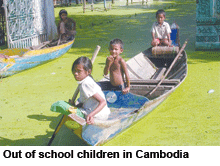Schools damaged in Cambodia’s worst monsoons in more than a decade may take up to a year to recover after flooding delayed the start of school for thousands of students nationwide, say aid workers and officials. As of late October, 323 out of 1,400 damaged schools were closed, although some have since reopened. Though flood waters have receded, how well those schools are functioning and how many remain closed is still unknown, as the government continues its damage assessment in a dozen flood-hit provinces.
At least 77 schools are beyond repair, while students and teachers were still pumping water out of dozens more, says the director of the education ministry’s construction department, Song Yen.
 Sam Sereyrath, general director of education at the ministry of education, estimates some 20,000 children remain out of school, based on the number of schools destroyed. Meanwhile, teachers warn that flooding had exacerbated the chronic shortage of books and other study materials. Purchases of 47,000 textbooks for 12 grades are under way while some schools simply opened their doors in October with no teaching materials, says Rong Chhun, president of the Cambodian Independent Teachers’ Association.
Sam Sereyrath, general director of education at the ministry of education, estimates some 20,000 children remain out of school, based on the number of schools destroyed. Meanwhile, teachers warn that flooding had exacerbated the chronic shortage of books and other study materials. Purchases of 47,000 textbooks for 12 grades are under way while some schools simply opened their doors in October with no teaching materials, says Rong Chhun, president of the Cambodian Independent Teachers’ Association.
Meanwhile the country’s progress towards attaining the Millennium Development Goal for primary school education is mixed: 94 percent of primary school-age children were enrolled in the 2009-2010 school year, but only 83 percent of students enrolled in primary school completed the 2008-2009 year. Lower secondary education goals cannot be achieved by 2015 at the current pace, according to a preliminary UN analysis of September 2010.
To mitigate the risk that the floods may derail progress in primary education, government guidelines to make up lost school hours must be enforced, says Denise Shepherd-Johnson, head of communications for the UN Children’s Fund (Unicef) in Cambodia. A downward trend in government spending on education — 19.2 percent of the budget in 2007 to 15.9 percent in 2012 — limits the education ministry’s ability to respond to the flooding, she adds.
Almost 10 percent of the country’s population, about 1.6 million people, was directly hit by the flooding, of whom about one-quarter million fled to higher ground and about 250 people died, according to the National Comm-ittee for Disaster Management’s most recent data. The flooding began in mid-July in the upper Mekong River, and then spread to 18 of the country’s 24 provinces as Cambodia’s largest lake, the Tonle Sap, more than doubled its monsoon-season size. Almost 20 million people have been affected since June in Thailand, Cambodia, Philippines, Vietnam and Laos, a major tragedy unreported in the Indian media.
Save the Children and the education ministry have set up more than 400 temporary schools in four of Cambodia’s worst-hit provinces, reaching more than 12,000 primary school students. “Every day a child is not in school increases the risk they drop out permanently in a disaster like this. If we can quickly get them back in school-like settings, the chances of this happening are reduced,” says Jasmine Whitbread, CEO of Save the Children International.
(Excerpted and adapted from www.irinnews.org)